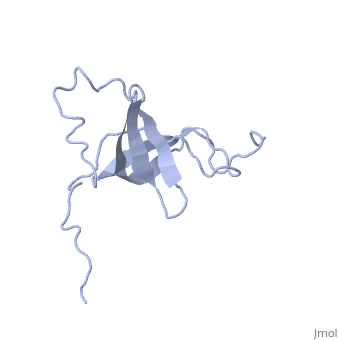2khi
From Proteopedia
NMR structure of the domain 4 of the E. coli ribosomal protein S1
Structural highlights
FunctionRS1_ECOLI Binds mRNA; thus facilitating recognition of the initiation point. It is needed to translate mRNA with a short Shine-Dalgarno (SD) purine-rich sequence. Evolutionary ConservationCheck, as determined by ConSurfDB. You may read the explanation of the method and the full data available from ConSurf. Publication Abstract from PubMedEscherichia coli ribosomal protein S1 is required for the translation initiation of messenger RNAs, in particular when their Shine-Dalgarno sequence is degenerated. Closely related forms of the protein, composed of the same number of domains (six), are found in all Gram-negative bacteria. More distant proteins, generally formed of fewer domains, have been identified, by sequence similarities, in Gram-positive bacteria and are also termed 'S1 proteins'. However in the absence of functional information, it is generally difficult to ascertain their relationship with Gram-negative S1. In this article, we report the solution structure of the fourth and sixth domains of the E. coli protein S1 and show that it is possible to characterize their beta-barrel by a consensus sequence that allows a precise identification of all domains in Gram-negative and Gram-positive S1 proteins. In addition, we show that it is possible to discriminate between five domain types corresponding to the domains 1, 2, 3, 4-5 and 6 of E. coli S1 on the basis of their sequence. This enabled us to identify the nature of the domains present in Gram-positive proteins and, subsequently, to probe the filiations between all forms of S1. Probing the relationship between Gram-negative and Gram-positive S1 proteins by sequence analysis.,Salah P, Bisaglia M, Aliprandi P, Uzan M, Sizun C, Bontems F Nucleic Acids Res. 2009 Sep;37(16):5578-88. Epub 2009 Jul 15. PMID:19605565[1] From MEDLINE®/PubMed®, a database of the U.S. National Library of Medicine. See AlsoReferences
| ||||||||||||||||||


